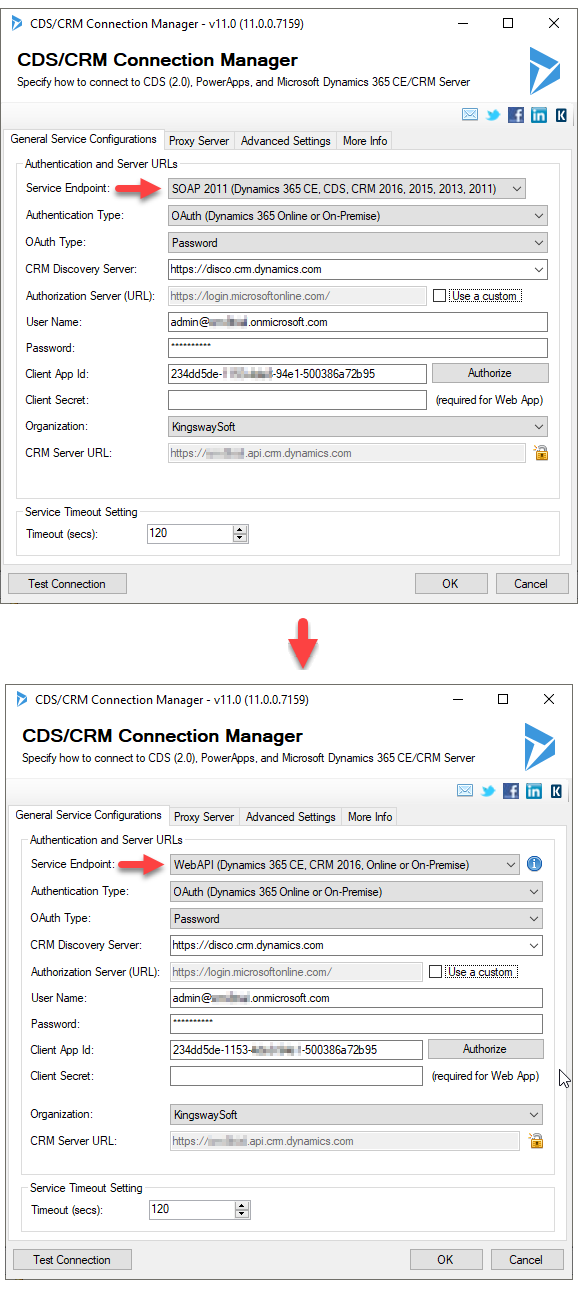What is WebAPI and why?
WebAPI is the latest web service interface for the CDS and Microsoft Dynamics 365 Customer Engagement platform. It is the new preferred API option when connecting to Microsoft Dynamics 365 Customer Engagement (CE). If you have been a professional Microsoft Dynamics 365 developer for a while, you must have heard that the SOAP 2011 service endpoint has been deprecated about 2.5 years ago. At the time that the SOAP 2011 is completely retired (or removed) from the Dynamics 365 platform in the future (not sure when at this moment, hopefully not sooner than its v11 release), WebAPI will be the final replacement. In comparison to the SOAP 2011 service endpoint which uses SOAP messages to interact with Dynamics platform, the WebAPI is a RESTful API based on OData (Open Data Protocol) v4.0 which uses JSON data structure for service requests. With that being said, for whatever development you might be working on, you should consider WebAPI as your first option when connecting to Microsoft Dynamics 365 CE for the following couple of reasons:
- WebAPI is a future-proof API - this is obvious as Microsoft has announced the deprecation of the SOAP service endpoint
- JSON is a light-weight message format, which makes the size of service request messages (also response messages) much smaller, therefore rendering shorter networking time which should result in better performance
In responding to the Microsoft move, our team at KingswaySoft has worked really hard in the last few months in trying to add WebAPI support to our SSIS Integration Toolkit for Microsoft Dynamics 365 product, which was finally made available in our Winter 2019 release announced last week. In this blog post, I will discuss the development experience with the new API and how you can switch.
- First of all, in order to access WebAPI support in our software, you need to upgrade your Dynamics 365 toolkit to the latest v11.0 release available at its download page.

- After you have installed the the latest release of our software, you can go ahead launch your SSDT environment, from which you can open up your existing packages or project.
- Once you have the project ready, you can open the connection manager by making a switch of the service endpoint to the WebAPI option.

- Although SOAP 2011 and WebAPI service endpoints use the same metadata system, it is important noting that WebAPI uses an additional property when working with lookup fields for writing. For this reason, if you switch from the SOAP 2011 service endpoint to WebAPI, you should perform a component refresh for each destination component that uses the updated connection manager. This is not required if you change the service endpoint from WebAPI to SOAP 2011 service endpoint, as the additional property will not make any impact other than being redundant.
Restrictions and Limitations
With all the benefits mentioned above, we have to report that there are certain restriction and limitations with Dynamics 365 WebAPI as of its most recent v9.2 release, which you should take into consideration when making the switch. We have highlighted those limitations in the connection manager when you hover over the "i" icon next to the Service Endpoint option as also described below (Updated on March 25, 2024 to reflect the most recent status as of our v23.2.2 release of SSIS Integration Toolkit).
- AuditLogs option in the CRM/CDS source component is only partially working, it does not currently return attribute change details properly.
- Using the Bypass Custom Business Logics option with Alternate Key Upsert action may cause a "412 Precondition Failed" error which complains about a record with the attribute values already exists. An alternative solution is to use manually specified keys as the matching criteria.
- CRM/CDS destination component that performs Update or Upsert using an alternate key may not work reliably, as WebAPI service endpoint does not handle alternate key values that contain special characters such as <,>,*,%,&,:,/,\,#.
- Using Duplicate Detection as the matching criteria for Upsert or Update action is not recommended, as the RetrieveDuplicates function that we rely on does not return those existing matching records reliably. Using the option for Upsert action could result in duplicate data. As an alternative solution, you may use the Manually Specify option, or otherwise, you may use the SOAP service endpoint if absolutely required. Note that we don't generally recommend using Duplicate Detection for matching purposes regardless of the service endpoint used.
- Bulk Delete action is not functioning as the FetchXmlToQueryExpression function will report an unexpected server-side error, which is a function that we rely on.
- Using Delete action for campaignactivityitem entity is not currently working due to disparity of the service request message used.
- Writing to campaignitem entity is not currently working due to disparity of the service request message used.
- Send action for the 'email' entity is not working, as it renders a server-side error when the request is posted to the server.
- When making an update to any party list fields in an activity entity (such as the 'from', 'to', 'cc', 'bcc' fields of 'email' entity), you need to make sure that you write to all party-list fields in the same entity, otherwise, those party-list fields that do not have an input will be cleared out, which could result in unexpected data losses.
It is important to note that none of the above restrictions were engineered by our team. If any of them are impacting your integration development, we recommend you use the SOAP service endpoint instead until the issues are addressed or resolved in a future Dynamics 365 release.

